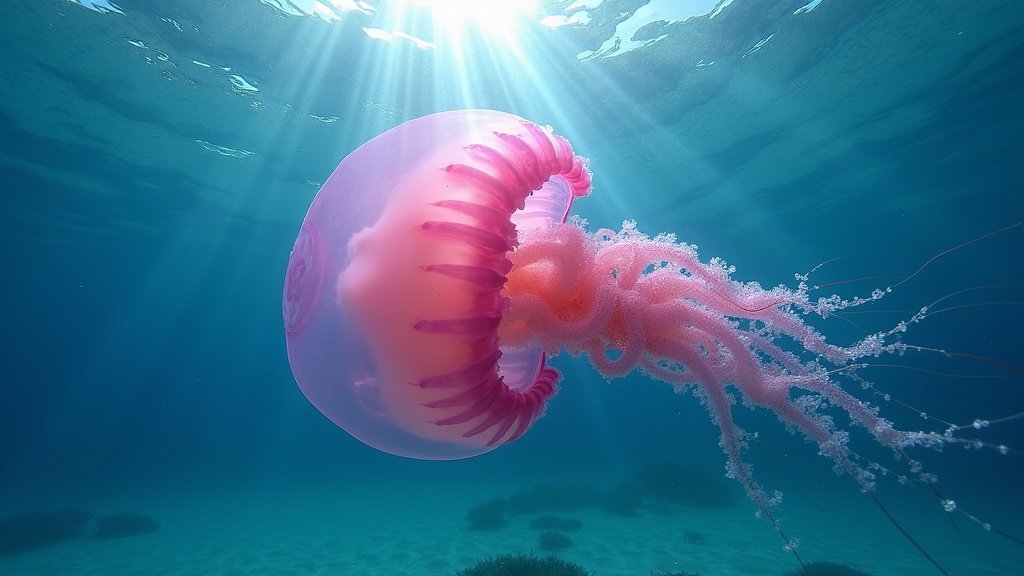The Texas coastline, a familiar stretch of sand and surf, has recently become the stage for an extraordinary marine spectacle: the appearance of the “pink meanie” jellyfish. Visitors to popular spots like Padre Island and Port Aransas have encountered these unusually large and vibrantly colored creatures, generating significant current buzz and fascination among beachgoers and scientists alike.
The Elusive Pink Meanie
The “pink meanie” is the colloquial name for Drymonema larsoni, a remarkable species of jellyfish that has captivated onlookers. Officially identified as a new species and even warranting the creation of its own biological family, Drymonematidae, in 2011, this jellyfish is a significant find. Its existence was first noted in the Gulf of Mexico in the early 2000s, but it wasn’t until further genetic and morphological analysis that scientists confirmed it was distinct from known species, not a relative from the Mediterranean as initially suspected.
These creatures are notable for their immense size, with bells that can exceed three feet in diameter and tentacles that can stretch an astonishing 70 feet. Weighing in at over 50 pounds, they possess a striking pink hue, often likened to cotton candy, though this color tends to fade once they are washed ashore.
A Feast for the ‘Meanie’: Jellyvorous Habits
The “meanie” moniker isn’t just for their imposing size; it hints at their aggressive predatory nature. Drymonema larsoni is a “jellyvorous” predator, meaning its diet consists almost exclusively of other jellyfish. Their preferred prey is the ubiquitous moon jellyfish (Aurelia species), a common sight in the Gulf of Mexico.
Pink meanies actively hunt these smaller jellies, ensnaring them with their long tentacles and drawing them towards their oral arms, where digestive juices begin to break them down. They are highly efficient feeders, capable of consuming multiple moon jellyfish within hours, playing a crucial role in regulating their populations. This predatory behavior is a key factor driving their appearance; a bloom of moon jellyfish inevitably attracts the pink meanies.
Unprecedented Sightings Along the Texas Coast
Recent weeks have seen an unusual surge in pink meanie sightings along the Texas coast, particularly in areas from Port Aransas to Corpus Christi and Padre Island. Jace Tunnell, director of community engagement at the Harte Research Institute at Texas A&M University-Corpus Christi, has been documenting these encounters, noting that he has observed more pink meanies this season than in his eight years of continuous beachcombing surveys. He reported spotting over 10 of these large jellies along a mere 10-mile stretch of beach recently.
These mass appearances are considered rare and noteworthy, as pink meanies typically only gather in large numbers when their food source is abundant. The current conditions in the Gulf have created a perfect storm for these creatures, leading to their increased visibility.
More Than Just a Pretty Pink Face: Sting and Safety
Despite their intimidating size and name, the sting of a pink meanie is surprisingly mild. Scientists who have been stung describe the sensation as minor, comparable to a mild rash or a pain level of about “2 out of 10”. This is a significant contrast to the severe stings of other marine invertebrates like the Portuguese man-of-war. While caution is always advised for individuals sensitive to stings, the pink meanie poses little danger to the average beachgoer.
Scientific Marvel: A New Family of Jellyfish
The discovery and classification of Drymonema larsoni represent a significant moment in marine biology. When first encountered in large numbers in the Gulf of Mexico around 2000, researchers initially believed they were a known species from the Mediterranean. However, detailed genetic and morphological studies by scientists like Keith Bayha proved otherwise, revealing Drymonema to be distinct enough to establish its own family – Drymonematidae. This marked the first new true jellyfish family described in nearly a century, underscoring the unique nature of the pink meanie.
Factors Behind the Bloom
The ephemeral nature of these jellyfish blooms is closely tied to environmental conditions. Pink meanies are highly sensitive to temperature, thriving in warmer waters and perishing if the water becomes too cold. Their presence is also directly linked to the abundance of moon jellyfish. When moon jelly populations boom, typically in late summer and early fall, the pink meanies follow suit, drawn by the plentiful food source. As cooler weather sets in or the moon jellyfish disappear, the pink meanies typically die off quickly.
This current news of the pink meanie’s impressive display on the Texas coast serves as a fascinating reminder of the ocean’s hidden wonders and the complex ecological relationships that govern marine life. For visitors fortunate enough to witness these giants of the deep, it’s a memorable encounter with a truly rare and remarkable inhabitant of the Gulf of Mexico.






